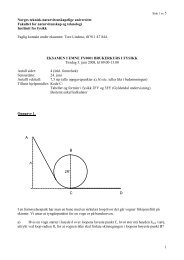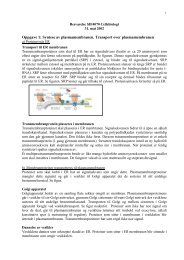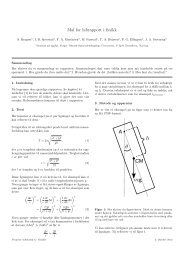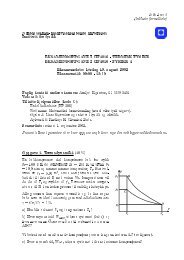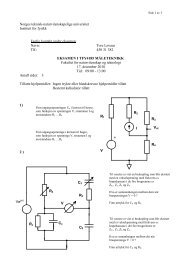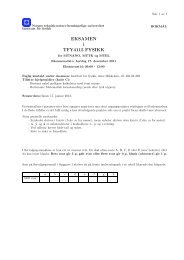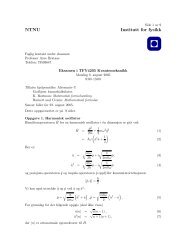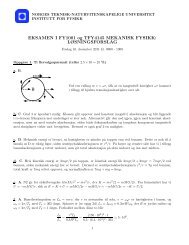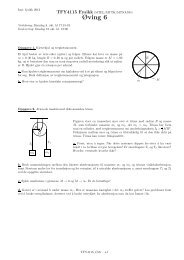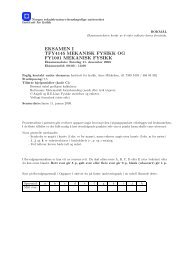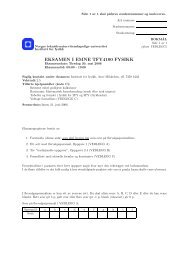DEPARTMENT OF PHYSICS, NTNU - intern - NTNU
DEPARTMENT OF PHYSICS, NTNU - intern - NTNU
DEPARTMENT OF PHYSICS, NTNU - intern - NTNU
You also want an ePaper? Increase the reach of your titles
YUMPU automatically turns print PDFs into web optimized ePapers that Google loves.
polymer interface was assumed graded, with a<br />
Gaussian smearing of a width 5.3Å. This particular<br />
film is seen to have a thickness of about 10 nm,<br />
corresponding to five repetitions units of the a-axis.<br />
The feature at scattering vector Q ~ 0.3Å -1 is a result of<br />
this <strong>intern</strong>al structure of the film, a Bragg-like signal<br />
interfering with the reflections from the interfaces. An<br />
exponentially damped harmonic variation of the<br />
electron density gave the best fit, a model sometimes<br />
used for smectic liquid crystals. The period of the<br />
modulation, 20.8 Å, is compatible with the a -<br />
parameter of solid POT of 20.4 Å. The model implies a<br />
well-developed layering near the air-polymer interface,<br />
decaying into the film, being least pronounced at the<br />
polymer-water interface, in qualitative agreement with<br />
the aliphatic side chains being hydrophobic.<br />
~R Q 4<br />
10 0<br />
10 -1<br />
10 -2<br />
10 -3<br />
10 -4<br />
10 -5<br />
10 -6<br />
~electron density<br />
x 10-6<br />
5<br />
4<br />
3<br />
2<br />
1<br />
Air Polymer Water<br />
0<br />
-50 0 50 100<br />
Depth in film / Å<br />
150<br />
0 0.05 0.1 0.15 0.2 0.25 0.3 0.35 0.4 0.45<br />
Q / Å -1<br />
Fig. 1. Reflectometry data (dots) as obtained from a<br />
thin POT film floating on water versus scattering<br />
vector Q=4πsinθ/λ. The solid line is the fit. For<br />
increased readability, the curves are multiplied by<br />
Q 4 .The inset shows the variation of the scattering<br />
density from air, through the film, into water. The<br />
damped periodic variation (unit cells) inside the<br />
polymer is shown.<br />
2. Atomistic modelling of the Al-Mg-Si<br />
precipitation sequence<br />
By A. Frøseth and R.. Holmestad<br />
In Al-Mg-Si alloys, small amounts of Mg and Si are<br />
added to the aluminium solution. When this solid<br />
solution is brought through a heat treatment process,<br />
small particles called precipitates will start to form.<br />
Now, these precipitates are of fundamental importance<br />
for increasing the strength of the aluminium, which by<br />
itself is a rather soft material.<br />
The precipitation sequence shows how the precipitates<br />
transform from one phase to another as<br />
the material is heat treated.<br />
SSSS -> Mg/Si Clusters -> GPZ -> β'' -> (β' + U2 + U1<br />
+ B') -> β<br />
17<br />
where SSSS is short for Super Saturated Solid<br />
Solution, and GPZ is short for Gunier Preston Zones.<br />
Just recently our group solved the crystallographic and<br />
electronic structure of the U1 and U2 phases using a<br />
combination of experimental and quantum mechanical<br />
modelling techniques. One of the most basic questions<br />
we would like to ask, is how the precipitate phases are<br />
constructed. The main building blocks are atoms - now<br />
how do they fit together? A well established theoretical<br />
tool for studying the electronic properties of a system<br />
of atoms is Density Functional Theory (DFT). We have<br />
used this technique both in the process of finding the<br />
crystallographic structure and in studying the electronic<br />
bonding properties of the precipitate phases. In the<br />
phases containing all three alloying elements - Al, Mg<br />
and Si - we have found that the structure is dominated<br />
by a strong bonding network between the Al and Si<br />
atoms which is made possible by the donation of<br />
electrons from the Mg atoms. The figures below show<br />
the bonding networks (indicated by the rods connecting<br />
Si and Al atoms) for the U1 and U2 precipitate phases.<br />
Fig. 1: U1 phase bonding network. Large grey spheres<br />
indicat Mg atoms, while the darker grey spheres<br />
indicate Al atoms and the small black spheres indicate<br />
Si atoms.<br />
Fig. 2: U2 phase bonding network<br />
We found that the MgAl2Si2, U1 phase can be<br />
categorized as belonging to a structure class called<br />
Zintl compounds, where each Mg atom donates 2<br />
electrons to each unit of Al2Si2, thereby obtaining a<br />
filled valence shell. The MgAlSi U2 phase belongs to<br />
the TiNiSi class. Also for this structure type the<br />
electropositive Mg atoms donate charge to a Al-Si<br />
bonding network, although the charge transfer is not<br />
sufficient to produce a closed shell sub-structure as for<br />
the U1 phase.



